Looking for an eye-catching addition to your houseplant collection? Sounds like may just be in need of a(nother) prayer plant! Let me introduce you to Calathea ornata, better known as the pinstripe prayer plant. This species’ stunning foliage is impossible to overlook!
Keep reading for everything you need to know about Calathea ornata care and how to grow this striped houseplant indoors.
| Common name(s) | Pinstripe prayer plant, pinstripe Calathea |
| Scientific name | Goeppertia ornata, previously Calathea ornata |
| Family | Marantaceae |
| Height & spread | Up to 3 feet high and wide |
| Light | Bright indirect |
| Soil type | Rich but well-draining |
| Water | Keep lightly moist |
Disclosure: If you shop from my article or make a purchase through one of my links, I may receive commissions on some of the products I recommend.
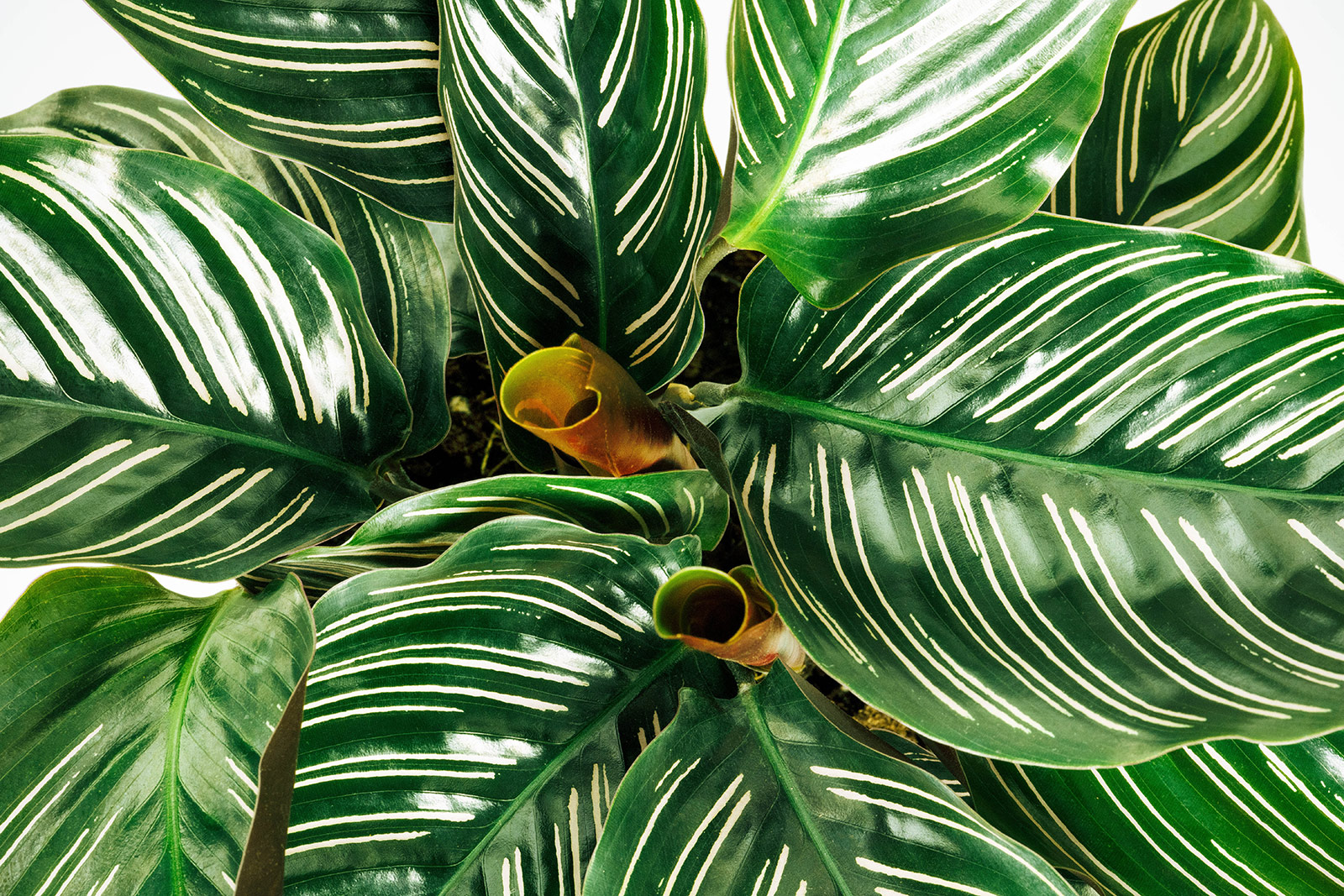
About Calathea ornata
Natural habitat
Calathea ornata is naturally found in Colombia like many of our other favorite houseplants (including Philodendron gloriosum, Anthurium andraeanum, and Tradescantia zebrina), although it has also been recorded in parts of Venezuela. Here, it grows in forests, woodland, and scrubland as part of the undergrowth.
Description
It’s no wonder that Calathea ornata is one of the most commonly sold prayer plants. This species is a beauty!
The wild form sports dark green elongated leaves on long, thin stems. The foliage is characterized by its very pronounced, silvery or pink leaf veins that look a little like pinstripes (which explains the common name of pinstripe prayer plant).
It’s an evergreen perennial that grows in a clumping manner from a central rhizome and can reach around 3 feet in height.
Like other prayer plants (such as Calathea orbifolia, Maranta leuconeura, and Stromanthe sanguinea), this species closes up its delicate leaves when night falls and opens them back up at dawn.
Taxonomy
If you’re a long-time houseplant enthusiast, you may have heard of the “great Calathea exodus.” Basically, a scientific review recently took place and it turned out that many plant species that had previously been placed in the genus Calathea, including Calathea ornata, actually belong to Goeppertia.
The whole mistake was caused by sloppy categorization, since botanists didn’t always realize at the time that some species look different as adults than as young plants.
A whopping 200 species were moved, but the commercial houseplant world isn’t quite as quick to catch on as the scientific side.
That’s why, to avoid confusion, I still refer to this plant as Calathea ornata in this post, even though it’s now technically called Goeppertia ornata. The same goes for the Plant Formerly Known As Calathea makoyana and many others.
Will the real Calathea ornata please stand up?
There are some other prayer plants that are very similar in looks to Calathea ornata. Together, they form what is referred to as the “Ornata complex,” which contains species like Calathea (or, technically, Goeppertia) majestica, vittata, and sanderiana. Their almost identical appearances have caused a lot of naming uncertainty.
One scientific writer calls the whole thing an “ornate confusion,” saying that true Calathea ornata doesn’t even exist in horticulture anymore and that the name is incorrect. He states it was replaced a long time ago by the more vigorous Calathea majestica!
Is your head spinning yet? That’s houseplant taxonomy for ya.
Luckily, in the end, it doesn’t actually matter for those of us just trying to grow plants in our homes. Care for all these Calatheas is the same anyway.
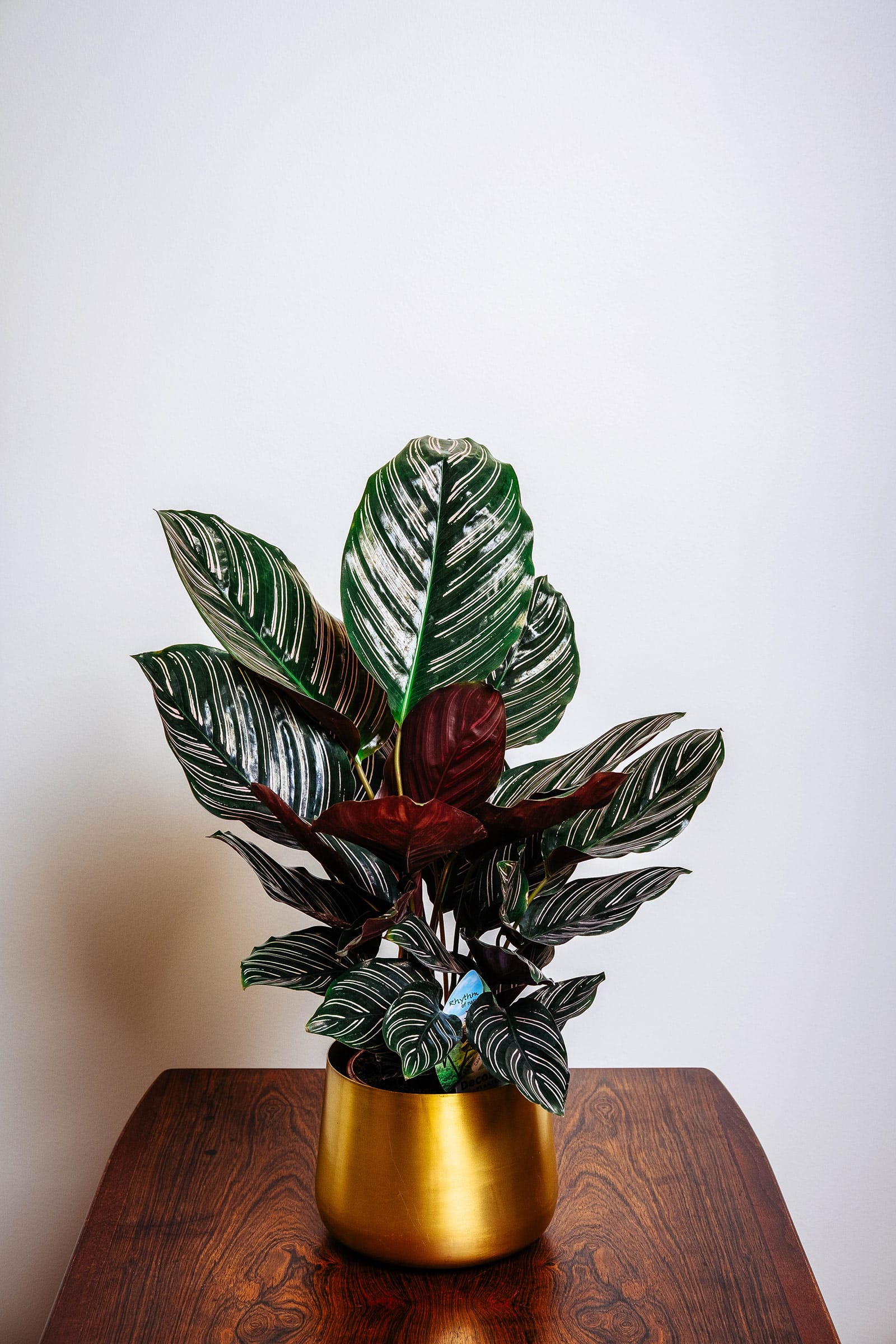
Calathea ornata varieties
Due to the taxonomical confusion described above, it isn’t always clear whether a plant you buy as a Calathea ornata variety is truly an ornata, or if it’s another similar prayer plant that was misnamed. Again, it’s not a huge problem, since their care requirements are identical.
The most commonly sold varieties include:
- Calathea ornata ‘Roseolineata’: Dark green leaves with silvery to pink leaf veins.
- Calathea ornata ‘Sanderiana’: Very dark green leaves with clear pink veins. This may in fact be Calathea sanderiana, a different species.
- Calathea ornata ‘Beauty Star’: Dark green foliage with light green vein area and silvery leaf veins.
The very similar Calathea ‘White Star’ is often mistaken for Calathea ornata, but it’s actually a majestica. Same pinstripes, different name.
(And not to make things even more confusing, but there’s an Aglaonema variety that looks nearly identical to Calathea ornata as well!)
Where to buy Calathea ornata plants:
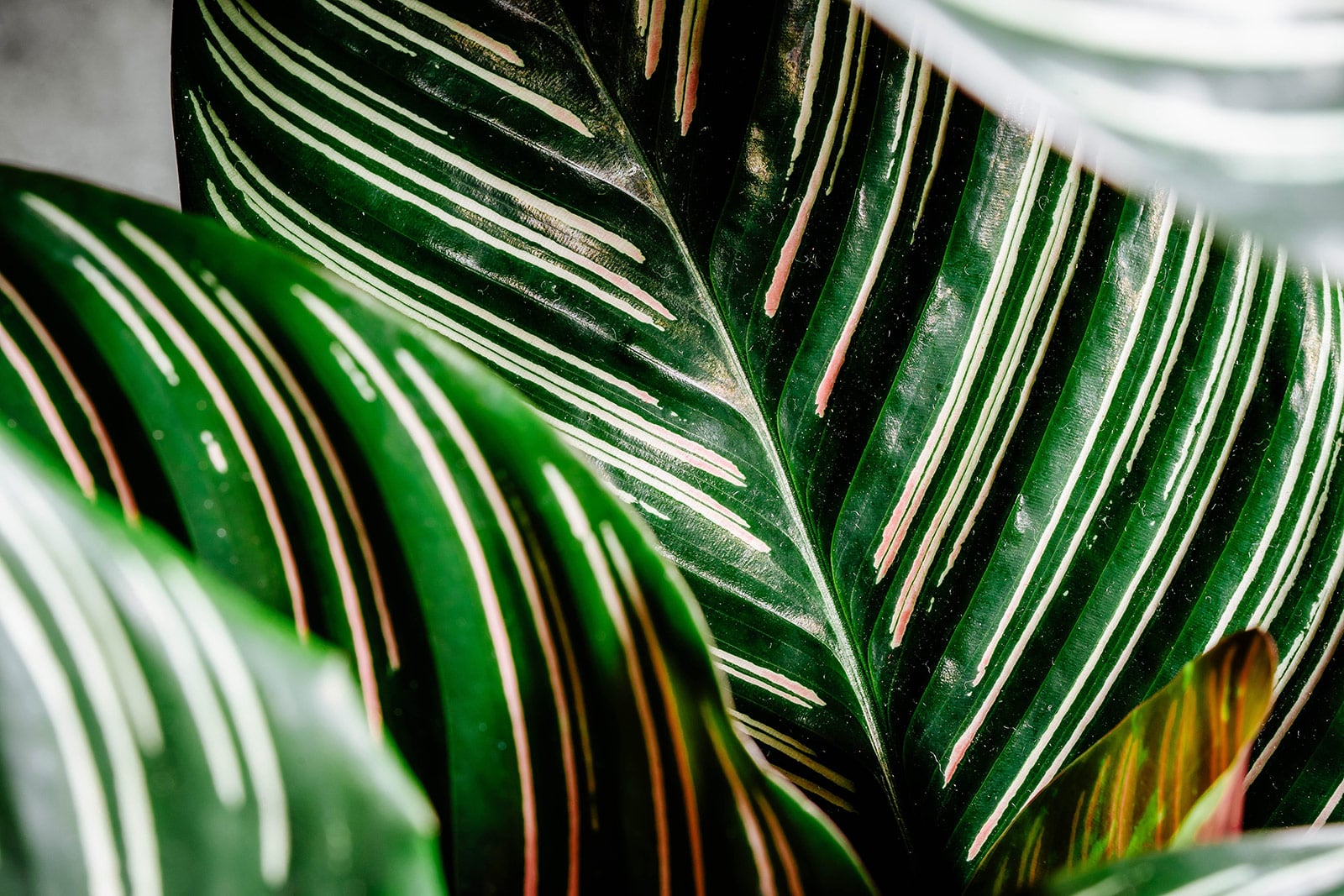
Caring for Calathea ornata
Light and temperature
As described in the section above on Calathea ornata’s natural habitat, this popular houseplant naturally grows in forested regions in tropical Colombia and Venezuela. This means the species isn’t used to being blasted with direct sun, as the harshest rays would naturally be filtered out by taller trees.
Your pinstripe Calathea loves light and it should be kept near a window, but make sure it gets gentle, indirect light. Artificial lighting also works well if you don’t have any windowsill space to offer, or you can grow the plant outdoors in a shaded spot.
In terms of temperature, this is a true tropical that despises the cold. Room temperature is great and significantly warmer isn’t a problem either, but your prayer plant will quickly stop growing if it’s exposed to temperatures below around 60°F. Take your plant back indoors in early fall and keep it away from A/C units or drafty windows to prevent problems.
Water and humidity
As with other prayer plants, it can be a little challenging to find the right watering balance for a Calathea ornata. These guys are jungle plants that love plenty of moisture, but they don’t react well at all to being left standing in water. You’ll have to find the sweet spot between moisture and drainage, a lot of which depends on the right soil mixture (which I’ll discuss below).
In terms of watering, you want to keep this plant’s soil lightly moist at all times, but never wet. During the summer growing months, water as soon as the top inch or two of the soil has gone dry. This may mean giving the plant a drink up to twice a week or even more.
When it’s inactive during the cool winter months, let the soil dry out a little further to prevent overwatering. Just never allow it to become bone dry: If your Calathea starts to wilt, you’ve probably waited too long.
Humidity is another important aspect that’s a bit tricky to get right. Prayer plants like this one are notorious for being finicky about humidity. If the air in your home is too dry, your plant won’t thrive, and it may fall prey to issues like spider mite infestations and crispy leaf tips.
The ideal air moisture levels for Calathea ornata are between 60 percent to 100 percent. If the humidity in your home regularly falls below 50 percent, it’s probably a good idea to use a humidifier. Your houseplants will thank you!
Quick tip
Is your prayer plant just not thriving despite your best efforts? You’re not a bad plant parent, this species is just a drama queen. Calathea/Goeppertia isn’t known to be the easiest houseplant to grow outside of a greenhouse environment. Sometimes our homes simply don’t suit them!
Soil and planting
The right soil mixture for your prayer plant can really help in preventing issues with waterlogging or drying out too fast. If you’re struggling to find the right watering balance, pay attention here.
Like many tropicals, Calathea ornata requires both excellent drainage as well as some water retention. Mixing your own soil is usually your best bet for prayer plant success. Try combining the following to make a suitable mix that doesn’t choke the roots or dry out too quickly:
- 2 parts high-quality houseplant potting soil (your soil base)
- 1 part coco coir or sphagnum moss (the water-retaining element)
- 1 part perlite (the drainage-enhancing element)
As for a planter for your pinstripe prayer plant, the most important thing is that it should have a drainage hole. Pots without drainage are best avoided unless you’re an experienced houseplant grower, as they can increase the risk of root rot in your plants.
Recommended products for Calathea ornata care:
- FoxFarm Ocean Forest Potting Soil
- Better-Gro Special Orchid Potting Mix
- Better-Gro Orchid Moss
- Burpee Organic Coconut Coir
- Perfect Plants Organic Perlite
Fertilizing
Calatheas aren’t heavy feeders, but that doesn’t mean your ornata won’t appreciate a few extra nutrients here and there. If your plant is growing well during the growing season, you can apply a diluted liquid houseplant fertilizer once or twice a month.
Don’t use fertilizer if your Calathea isn’t doing well or if it isn’t growing (like during the winter months). It won’t help the plant perk up and instead, can actually end up damaging the roots.
Recommended fertilizers for Calathea ornata:
- Houseplant Resource Center Liquid Fertilizer for Houseplants
- Instant Biologics Instant Plant Food (Fizzing Nutrient Tablets)
- Maxsea All-Purpose Seaweed Plant Food
Pruning
You usually won’t have to do any pruning on your Calathea ornata, aside from the occasional removal of dead leaves. This is one area that’s easy peasy!
Dividing or repotting
As mentioned earlier, the pinstripe Calathea has a clumping growth habit and grows from a central rhizome. This means new shoots pop up next to the mother plant on a regular basis if your plant is healthy.
Should you pot these up separately to give the original plant space, or repot the whole thing into a bigger planter? It’s up to you!
Division is the only way to propagate a Calathea and it’s a good way to acquire new plants to keep or give away. If you keep repotting the plant in one piece year after year, though, you can end up with a spectacularly huge specimen.
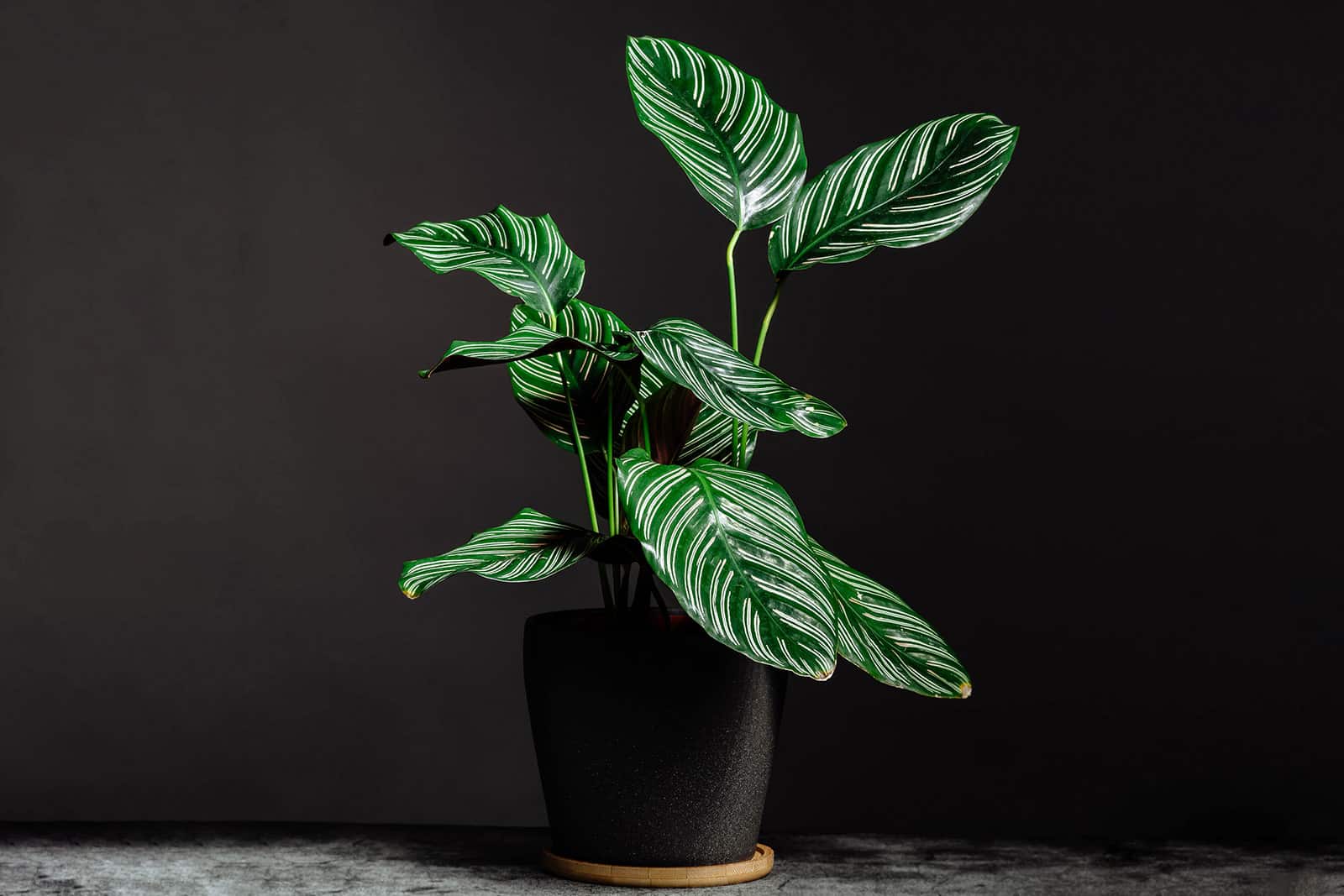
Propagating Calathea ornata
As discussed above, this houseplant can’t be multiplied using the tried and tested standard method of stem propagation. If you cut leaves, there is a small chance they will root in water, but they’ll never produce new foliage.
If you’d like to propagate your Calathea ornata, you’ll instead have to do so using the division method. It’s easy!
Just take the plant out of its container (like if you were going to repot anyway) and you may see clumps starting to come apart by themselves.
If that’s not the case, make a vertical cut through the rhizome using a clean knife to divide it. Make sure each clump has at least a few leaves and some roots.
Give each section its own new planter with fresh Calathea soil and you’re done! You can resume normal watering, since your brand new prayer plants already have their own root systems. They can look a bit limp for a few weeks while they adjust, but once you see new leaf growth, you’ll know you’re in the clear.
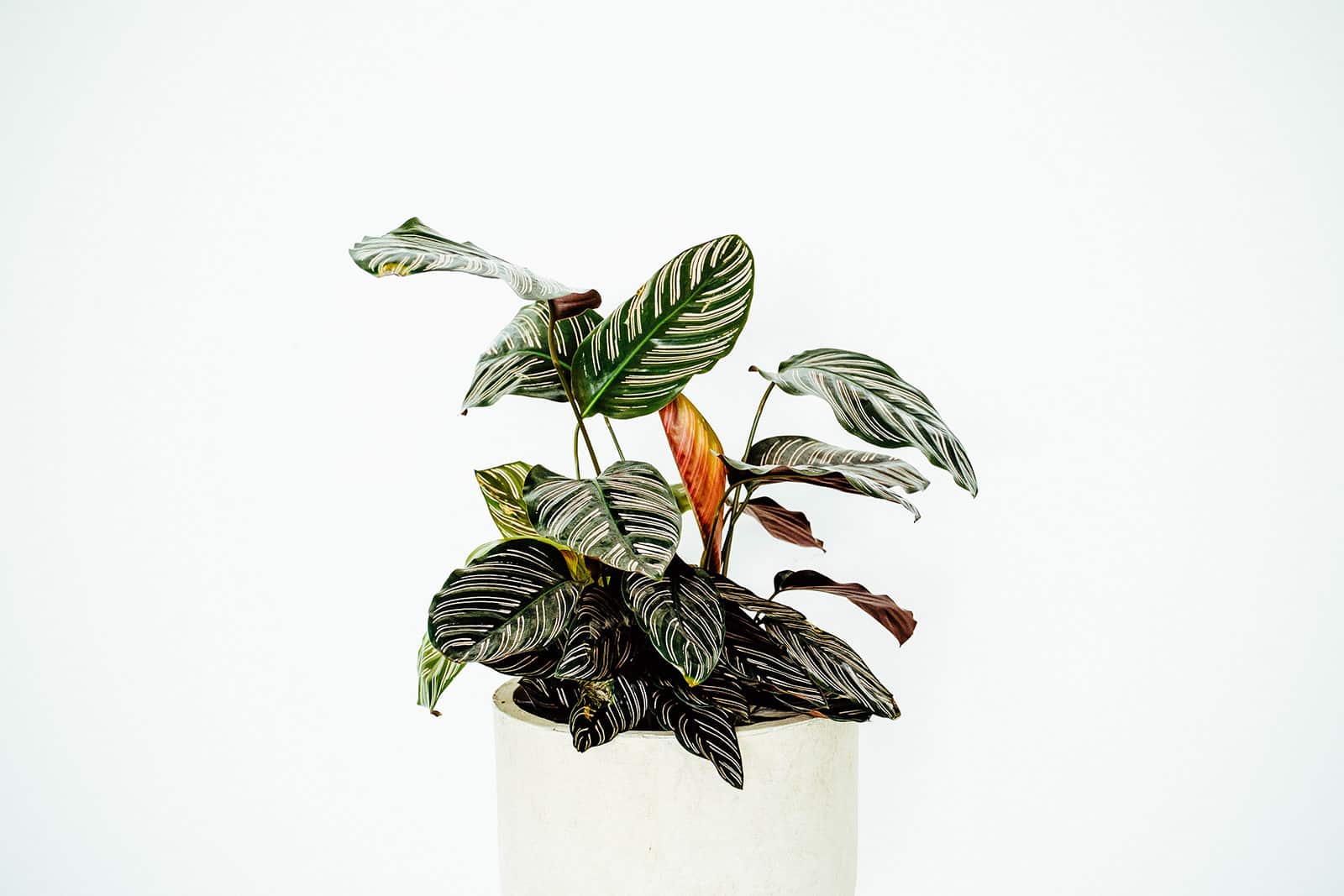
Common questions about Calathea ornata care
Why does my Calathea ornata have dry leaf edges?
There are two common causes for leaf edges (and even entire leaves) becoming crispy in prayer plants. The first is a lack of humidity, so if you don’t have one yet, consider buying a cheap humidity meter (like this one) to help you figure out whether you may need to run a humidifier.
Secondly, this houseplant can be sensitive to the minerals in tap water. Calatheas don’t deal well with the chloramine, fluoride, and other elements that may be present.
You don’t have to switch to bottled water unless what comes out of your tap is very low quality, but it can be very helpful to flush your Calathea ornata’s soil with distilled water every few months. This removes any mineral build-up that may be affecting its foliage.
Is Calathea ornata toxic to cats and dogs?
Nope! One of the great things about Calatheas/Goeppertias is that they are non-toxic to pets and humans.
Source:
- Kennedy, H. (1994, August). Calathea ornata and relatives, an ornate confusion. In II International Symposium on Taxonomy of Cultivated Plants 413 (pp. 169-176).


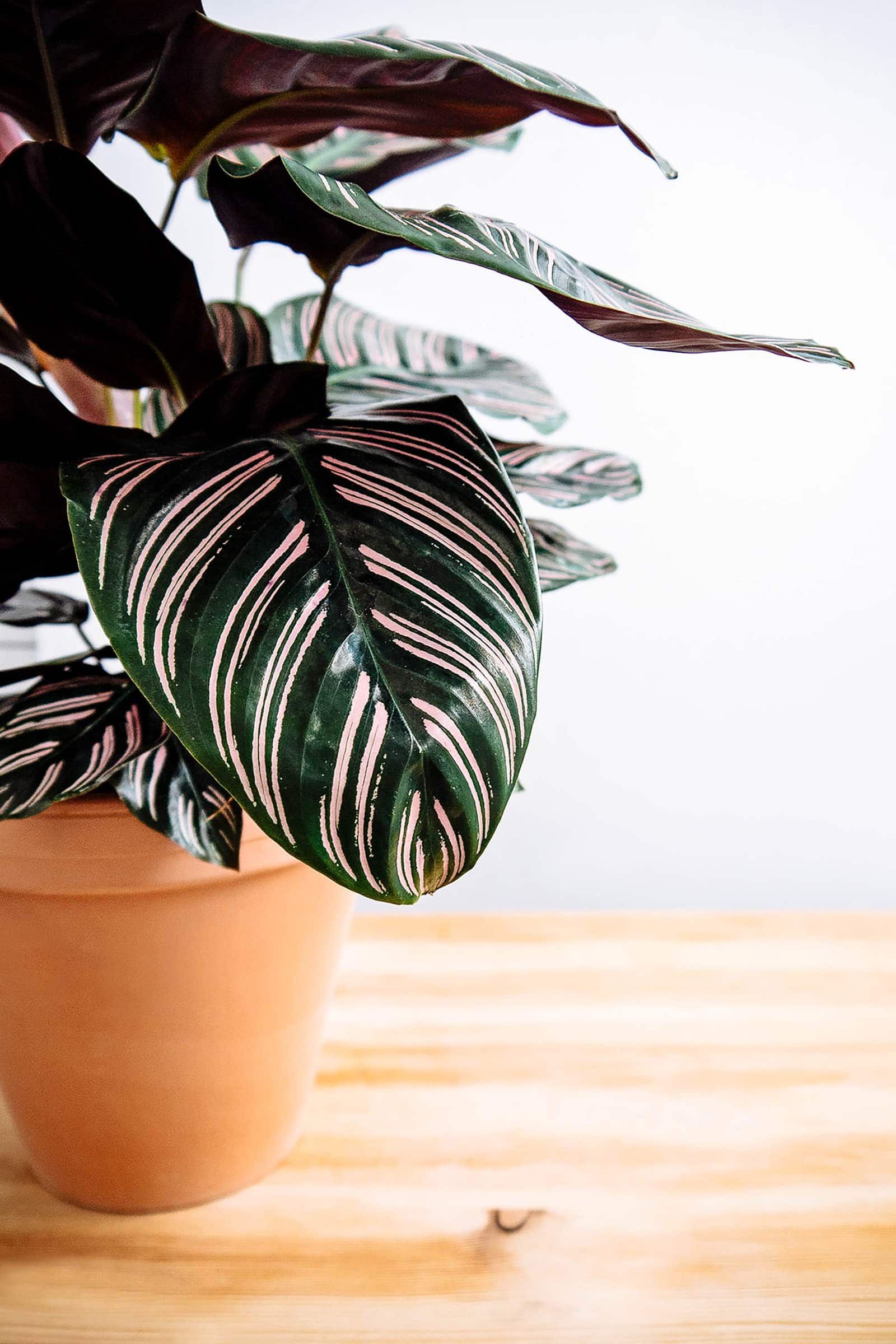













Mix everything together.
Great info! Can you give details on how to layer the soil for this plant. Is it Perlite on the bottom, soil in the middle and moss on the top or do you just mix everything together?
Mix everything together